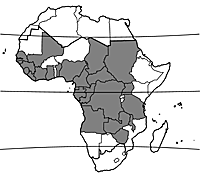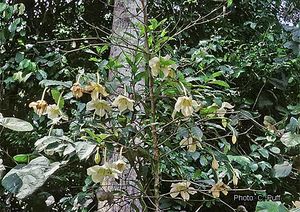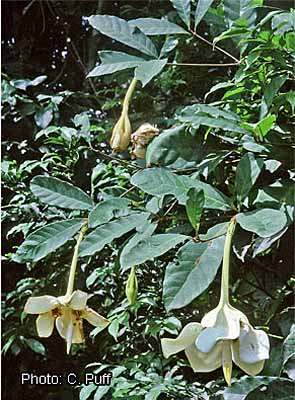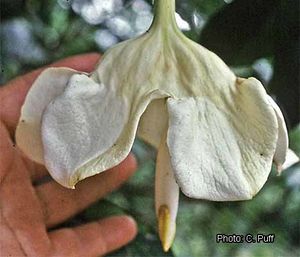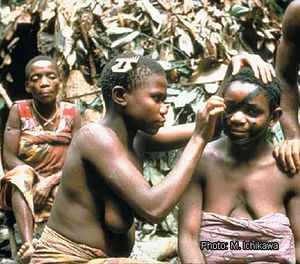Rothmannia whitfieldii (PROTA)
Introduction |
| General importance | |
| Geographic coverage Africa | |
| Geographic coverage World | |
| Dye / tannin | |
| Medicinal | |
| Ornamental | |
Rothmannia whitfieldii (Lindl.) Dandy
- Protologue: F.W.Andrews, Flow. pl. Anglo-Aegypt. Sudan 2: 461 (1952).
- Family: Rubiaceae
Synonyms
- Randia malleifera (Hook.) Hook.f. (1873).
Origin and geographic distribution
Rothmannia whitfieldii is widespread in tropical Africa, from Senegal east to Sudan, and south to Angola and Zimbabwe.
Uses
The fruit juice and fresh seeds contain a blue-black dye, which is widely used in tropical Africa as a cosmetic for body decoration, to mark an outline for tattooing and to rub into tribal markings in the skin to make them more conspicuous. The dye is said to be permanent. To dye barkcloth (‘pongo’) plain black, or decorate them with designs, the Mbuti, the Efe Pygmies and the Balese cultivators of the Ituri forest in north-eastern DR Congo, warm the soft pulp in the fruit on a fire, crush it and the black liquid obtained is mixed up with charcoal powder for drawing designs. They also change the colour to greyish-blue by adding lemon juice on the entire dyed cloth or on some designs only.
The dye is sometimes employed together with dye prepared from the pods and seeds of Piliostigma thonningii (Schumach.) Milne-Redh. It is also used to dye fabrics and as ink. The wood is hard and used for hoe-handles. Rothmannia whitfieldii is considered to possess febrifugal, anti-diarrhoeic and ecbolic properties. The fruit juice is applied to sores and wounds to promote healing, and in Tanzania to leprous areas of the skin. In East Africa it is applied to eczema on the toes. Drinking of cold water in which chips of the root bark have been steeped provokes abundant expectoration and is a relief for asthma. In southern Africa root ash is used as a cicatrizant on wounds and to treat eczema on the toes. In Sierra Leone charred fruits are used to strengthen palm wine. With its large, pendulous, sweet-scented, white or brownish-white flowers Rothmannia whitfieldii is potentially an attractive ornamental.
Properties
No chemical study of the colorants or dye-precursors present in the flowers and fruits is available for Rothmannia whitfieldii but presumably the fruit pulp contains alkaloids with dyeing properties like several other Rothmannia species with similar uses. In the bark and leaves alkaloid is present. The bark and root contain saponin. The wood has molluscicidal potential: a water extract kills the freshwater snail Bulinus globulus at 100 ppm.
Description
- Shrub or small tree up to 15 m tall; young stems pubescent.
- Leaves opposite, simple and entire, leathery; stipules triangular, 2–6 mm long, deciduous; petiole up to 2 cm long; blade elliptical to obovate, 9–29 cm × 3–13 cm, base cuneate, apex acuminate, pinnately veined with 8–15 pairs of lateral veins, almost glabrous.
- Flowers solitary, pendent, terminal on short axillary branches, bisexual, regular, 5-merous, sweetly scented; pedicel up to 2.5 cm long, red pubescent, bearing 2–6 triangular bracteoles 2.5–3 mm long; calyx tubular, red-brown pubescent, tube up to 2.5 cm long, 10-grooved when dry, lobes linear, up to 8 cm × 4 mm; corolla trumpet-shaped, white, sometimes with purple spots, 7–30 cm long, lobes ovate, 1.5–7 cm × 1.5–8 cm, red-brown pubescent; stamens inserted in corolla tube, included or tips of anthers exserted; ovary inferior, 2-celled, style 7–19 cm long, abruptly widened at the wholly or partly exserted 2-lobed and 3–7.5 cm long stigma.
- Fruit a globose berry 3–7 cm in diameter, smooth to strongly 10-ribbed, velvety brown pubescent when young but glabrescent, many-seeded, crowned by the persistent calyx.
- Seeds lens-shaped, 7–11 mm × 3–4 mm.
Other botanical information
Rothmannia comprises about 30 species, distributed in tropical Africa, Madagascar and Asia. About 18 species are present in tropical Africa. Rothmannia whitfieldii is an extremely variable species, e.g. flowers with long or short tubes occur.
Ecology
Rothmannia whitfieldii occurs in forest undergrowth, often in old secondary forest, but also in savanna woodland, up to 1700 m altitude.
Genetic resources
Rothmannia whitfieldii is widespread in tropical Africa and is not in danger of genetic erosion.
Prospects
The dye, medicinal and ornamental properties of Rothmannia whitfieldii make it an interesting species, deserving more research.
Major references
- Bridson, D. & Verdcourt, B., 1988. Rubiaceae (part 2). In: Polhill, R.M. (Editor). Flora of Tropical East Africa. A.A. Balkema, Rotterdam, Netherlands. pp. 415–747.
- Burkill, H.M., 1997. The useful plants of West Tropical Africa. 2nd Edition. Volume 4, Families M–R. Royal Botanic Gardens, Kew, Richmond, United Kingdom. 969 pp.
- Dalziel, J.M., 1937. The useful plants of West Tropical Africa. Crown Agents for Overseas Governments and Administrations, London, United Kingdom. 612 pp.
- Irvine, F.R., 1961. Woody plants of Ghana, with special reference to their uses. Oxford University Press, London, United Kingdom. 868 pp.
- Tanno, T., 1981. Plant utilization of the Mbuti Pygmies - with special reference to their material culture and use of wild vegetable foods. African Study Monographs 1: 1–53.
- Terashima, H., Ichikawa, M. & Sawada, M., 1988. Wild plant utilization of the Balese and the Efe of the Ituri Forest, the Republic of Zaire. African Study Monographs, Supplement 8. The Center for African Area Studies, Kyoto University, Kyoto, Japan. 78 pp.
Other references
- Abbiw, D.K., 1990. Useful plants of Ghana: West African uses of wild and cultivated plants. Intermediate Technology Publications, London and Royal Botanic Gardens, Kew, Richmond, United Kingdom. 337 pp.
- Andrews, F.W., 1952. The flowering plants of the Anglo-Egyptian Sudan, Volume 2. Buncle, Arbroath, United Kingdom. 485 pp.
- Gassita, J.N., Nze Ekekang, L., De Vecchy, H., Louis, A.M., Koudogbo, B. & Ekomié, R. (Editors), 1982. Les plantes médicinales du Gabon. CENAREST, IPHAMETRA, mission ethnobotanique de l’ACCT au Gabon, 10–31 juillet 1982. 26 pp.
- Hallé, N., 1970. Rubiacées (2e partie). Flore du Gabon. Volume 17. Muséum National d’Histoire Naturelle, Paris, France. 335 pp.
- Hepper, F.N. & Keay, R.W.J., 1963. Rubiaceae. In: Hepper, F.N. (Editor). Flora of West Tropical Africa. Volume 2. 2nd Edition. Crown Agents for Oversea Governments and Administrations, London, United Kingdom. pp. 104–223.
- Neuwinger, H.D., 2000. African traditional medicine: a dictionary of plant use and applications. Medpharm Scientific, Stuttgart, Germany. 589 pp.
- Raponda-Walker, A. & Sillans, R., 1961. Les plantes utiles du Gabon. Paul Lechevalier, Paris, France. 614 pp.
- Sonké, B. & Simo, A.K., 1996. Révision systématique du genre Rothmannia (Rubiaceae-Gardeniae) au Cameroun. Bulletin du Jardin Botanique National de Belgique 65(1–2): 219–247.
- Somers, C. & Robbrecht, E., 1991. A precursor to the treatment of Rothmannia (Rubiaceae - Gardenieae) in ‘Flore d’Afrique Centrale’. Bulletin du Jardin Botanique National de Belgique 61: 295–304.
Sources of illustration
- Irvine, F.R., 1961. Woody plants of Ghana, with special reference to their uses. Oxford University Press, London, United Kingdom. 868 pp.
Author(s)
- P.C.M. Jansen, PROTA Network Office Europe, Wageningen University, P.O. Box 341, 6700 AH Wageningen, Netherlands
Correct citation of this article
Jansen, P.C.M., 2005. Rothmannia whitfieldii (Lindl.) Dandy. In: Jansen, P.C.M. & Cardon, D. (Editors). PROTA (Plant Resources of Tropical Africa / Ressources végétales de l’Afrique tropicale), Wageningen, Netherlands. Accessed 6 March 2025.
- See the Prota4U database.

